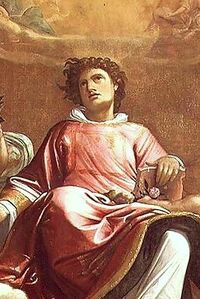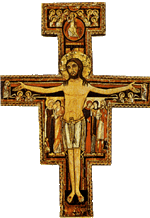| Saint Stephen The Protomartyr and Archdeacon | |
|---|---|
| St. Stephen (detail) by Giacomo Cavedone 1601 | |
| Deacon and Protomartyr | |
| Born | 1st century |
| Died | c. 35, Jerusalem |
| Venerated in | Roman Catholic Church, Eastern Orthodox Church, Oriental Orthodox Church, Eastern Catholic Churches, Lutheran Church, Anglican Communion |
| Feast | 26 December (Western) 27 December (Eastern) |
| Attributes | stones, dalmatic, censer, miniature church, Gospel Book, martyr's palm. In Eastern Christianity he often wears an orarion |
| Patronage | Acoma Indian Pueblo; casket makers; Cetona, Italy; deacons; headaches; horses; Kessel, Belgium; masons; Owensboro, Kentucky; Passau, Germany; Serbia; Republic of Srpska; Prato, Italy [1] |
Saint Stephen (Koine Greek: Στέφανος, Stephanos), known as the protomartyr of Christianity, is venerated as a saint in the Roman Catholic, Anglican, Lutheran and Eastern Orthodox Churches. Stephen means "wreath" or "crown" in Greek. He was one of the first in the early Church to bear the title Archdeacon.
Martyrdom[]
According to the Acts of the Apostles Stephen was tried by the Sanhedrin (Supreme Court) for blasphemy against Moses and God (Acts 6:11) and speaking against the Temple and the Law (Acts 6:13-14) (see also Antinomianism). He was stoned to death (c. A.D. 34–35) by an infuriated mob encouraged by Saul of Tarsus, the future Saint Paul: "And Saul entirely approved of putting him to death" (8:1). [2]. Stephen's final speech was presented as accusing the Jews of persecuting prophets who spoke out against their sins:
- '"Which one of the Prophets did your fathers not persecute, and they killed the ones who prophesied the coming of the Just One, of whom now, too, you have become betrayers and murderers." (7:52)
Saint Stephen's name is simply derived from the Greek Stephanos, meaning "crown", which translated into Aramaic as Kelil. Traditionally, Saint Stephen is invested with a crown of martyrdom for Christianity; he is often depicted in art with three stones and the martyrs' palm. In Eastern Christian iconography, he is shown as a young beardless man with a tonsure, wearing a deacon's vestments, and often holding a miniature church building or a censer.
Theophany[]
As he was on trial and being prosecuted, Saint Stephen experienced a theophany. His theophany was unusual in that he saw both the Father and the Son:
- "Behold, I see the heavens opened, and the Son of man standing on the right hand of God." (Acts 7:56)
Identification with James the Just[]
A theory has been put forward,[1] that Stephen, "crown" in English, would actually have been a codename for James the Just, the long-time leader of Jerusalem church who was put to trial by Sanhedrin and stoned in about 62 AD, almost 30 years later than Stephen. Thus, the story about Stephen's trial and stoning would have been a description, or at least a dramatisation, of the last moments of James the Just, which the author of the Acts deliberately or unknowingly inserted to a chronologically incorrect place, simultaneously creating a new martyr for the early church.
The fact that Stephen appears from nowhere, is sentenced to death in an emotional public trial without Romans interfering at all and is then altogether forgotten as if nothing happened, is already suspicious, but both his and James' trials also share a great deal of similarities. For example, according to Eusebius, James the Just said this as his last defence before taken to be stoned:
"Why ask ye me concerning Jesus the Son of man? He Himself sitteth in heaven, at the right hand of the Great Power, and shall come on the clouds of heaven."
which compares to Stephen's words, his last defence as well:
But Stephen, full of the Holy Spirit, looked up to heaven and saw the glory of God, and Jesus standing at the right hand of God. "Look," he said, "I see heaven open and the Son of Man standing at the right hand of God."
As their last words, both James and Stephen ask for forgiveness to their executioners.
Mention of the Province of Cilicia at Acts 6:9 seems to indicate that Stephen's story is written at least a decade after the death of James the Just. The Roman province by that name had been on hiatus from 27 BC and re-established by Emperor Vespasian only in 72 AD.
St. Stephen's Day[]
In Western Christianity, 26 December is called "St Stephen's Day", the "feast of Stephen" of the English Christmas carol, "Good King Wenceslas". It is a public holiday in many nations that were historically Catholic, Anglican and Lutheran: Austria, Croatia, the Czech Republic, Slovak Republic, Poland, Republika Srpska, United Kingdom (where it is also called "Boxing Day"), Ireland, Italy, Germany, Finland, Canada, Australia and New Zealand. In Catalonia (though not elsewhere in Spain), it is called Sant Esteve and is a bank holiday. In France, the day of Saint Étienne is a bank holiday in the Alsace-Moselle region, but not elsewhere. 26 December is also a holiday in Tuguegarao City, Philippines, which celebrates a fiesta in honor of St Stephen Protomartyr, its patron saint.
In the Eastern Orthodox Church and those Eastern Catholic Churches which follow the Byzantine Rite, St. Stephen's feast day is celebrated on December 27. (This date in the Julian Calendar currently corresponds to January 9 in the Gregorian Calendar.) This day is also called the "Third Day of the Nativity".
The General Roman Calendar included also on 3 August a feast of the Invention of the Relics of St Stephen — "Invention," (Latin: inventio), meaning "finding" or "discovery" — to commemorate the finding of St Stephen's relics during the reign of Emperor Honorius. In the Tridentine Calendar, this feast was celebrated as a "Semidouble", a rank that it lost in 1955, when Pope Pius XII reduced it to the rank of "Simple".[2] It was one of the second feasts of a single saint removed from the calendar by Pope John XXIII in 1960,[3] and so is not celebrated by those who, in accordance with Pope Benedict XVI's motu proprio, Summorum Pontificum, observe the 1962 calendar.
The Eastern Orthodox Church celebrates the discovery (opening) of the Saint's relics on September 15 and the Translation of the Relics of Protomartyr Stephen on August 2. The September 15 feastday celebrates the discovery of Stephen's relics in 415 CE, after which they were solemnly transferred to a church built in his honor in Jerusalem. Later, during the reign of Emperor Theodosius the Younger (408-450), the relics were transported to Constantinople, the event commemorated on Aug 2. Jan 4 marks the commemoration of the "Synaxis of the 70 Apostles". Since St. Stephen was included in these 70 Apostles mentioned in the "Acts of the Apostles", he is also remembered on Jan 4. Saint Stephen was a great leader of the Church.
Tomb[]
Many churches are named in honor of Saint Stephen, but there was no official "Tomb of St Stephen" until 415. When Christian pilgrims were traveling in large numbers to Jerusalem, a priest named Lucian said he had learned by a vision that the tomb was in Caphar Gamala, some distance to the north of Jerusalem.
Gregory of Tours reported that the intercession of Stephen preserved an oratory dedicated to him at Metz, in present-day France. His relics were preserved when the oratory was left standing, after Huns burned the remainder of the city on Easter Eve, 451.
Commemorative places[]
- Vienna, Austria - Stephansdom, the Cathedral of St. Stephen, founded 1147 and seat of Cardinal Archbishop of Vienna. Symbol of the city of Vienna and of Austria, has the tallest spire in Austria and is the country's most famous church
- Rome - San Lorenzo fuori le Mura, where his remains are interred with those of the eponymous saint under the altar
- Old city of Jerusalem - the "Lions' Gate" is also called St. Stephanus Gate, after the tradition that Stephen's stoning occurred here, though it probably occurred at Damascus Gate
- London - St Stephen's Chapel in the Palace of Westminster was originally built in the reign of King Henry III; it became the first site of the debating chamber of the House of Commons
- Dublin - St. Stephen's Green
- Manila, Philippines - St. Stephen's Parish and St. Stephen's High School
- San Salvador, El Salvador, San Esteban, San Salvador
- Brisbane, Queensland, Australia - The Cathedral of St. Stephen, Brisbane
- St Stephen's House, Oxford - Permanent Private Hall of the University of Oxford and Anglican Theological College
References[]
- ↑ Robert Eisenman, James the Brother of Jesus: The Key to Unlocking the Secrets of Early Christianity and the Dead Sea Scrolls. Viking Penguin, 1997, xxxvi + 1074 pp. ISBN 0-670-86932-5.
- ↑ General Roman Calendar of Pope Pius XII
- ↑ General Roman Calendar of 1962
- "Stephen, Saint". Encyclopedia Britannica. Volume 11 (15th edition ed.). 1974. pp. 250–251.
- Latourette, Kenneth Scott (1975). "The Sweep of Christianity Across the Græco-Roman World". A History of Christianity (1st paperback edition ed.). New York: Harper & Row. pp. 67–68. ISBN 0060649526.
- Nixon, R. E. (1962). "Stephen". in J. D. Douglas. The New Bible Dictionary. Grand Rapids: Wm. B. Eerdmans. pp. 1216. ISBN 0-8028-2282-7.
External links[]
| Wikimedia Commons has media related to: Saint Stephen |
- "St. Stephen". Catholic Encyclopedia. 1913. http://www.newadvent.org/cathen/14286b.htm.
- st stephen day
- Apostle Stephen the Archdeacon of the Seventy Orthodox icon and synaxarion
- Translation of the relics of the Protomartyr and Archdeacon Stephen from Jerusalem to Constantinople
- St Stepehens orthodox cathedral Kudasanad
| |||||||||||
| ||||||||||||||||||||||||||||||||||||||||||
| ||||||||||||||||||||||||||||||||||||||||||||



